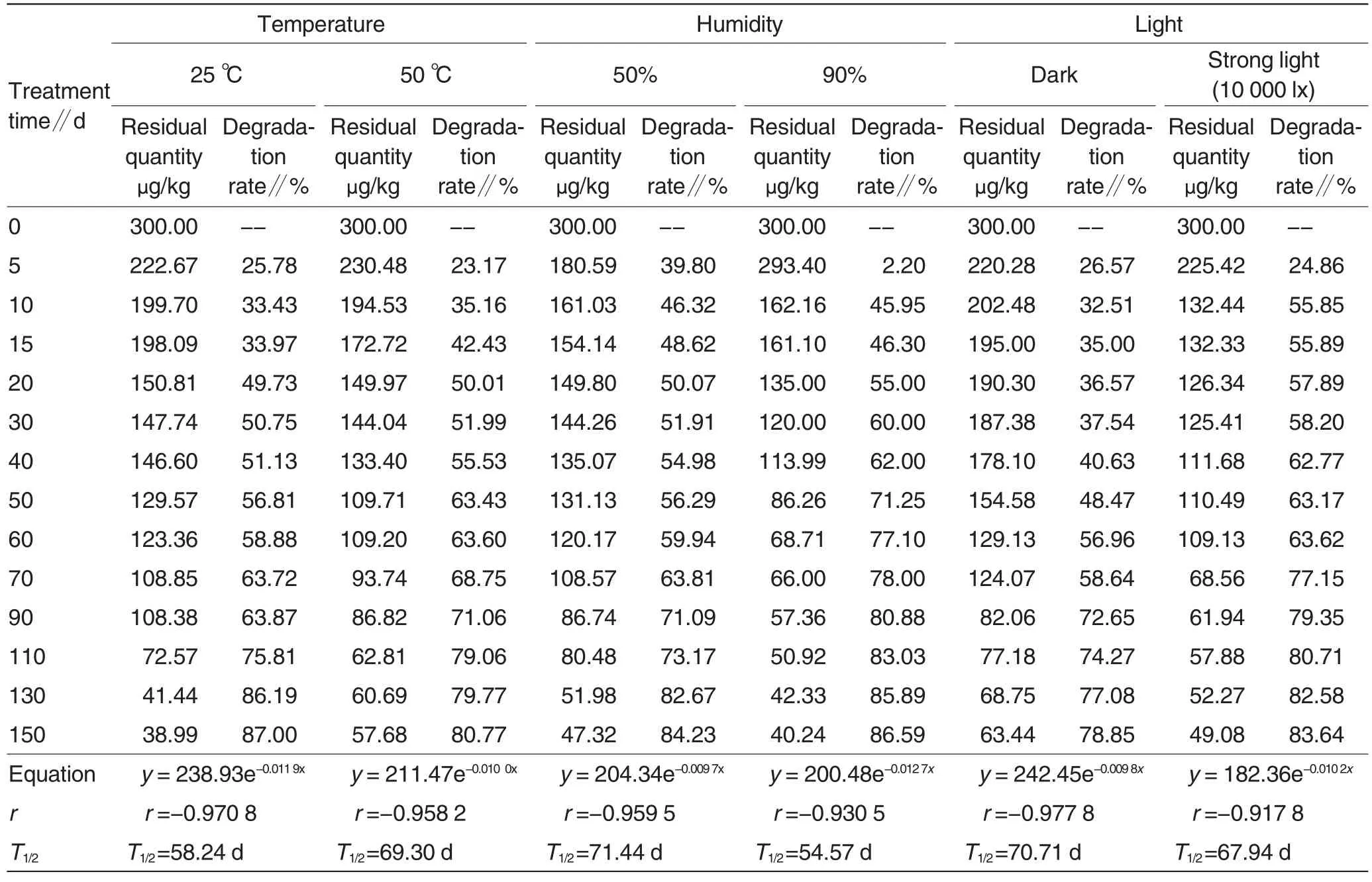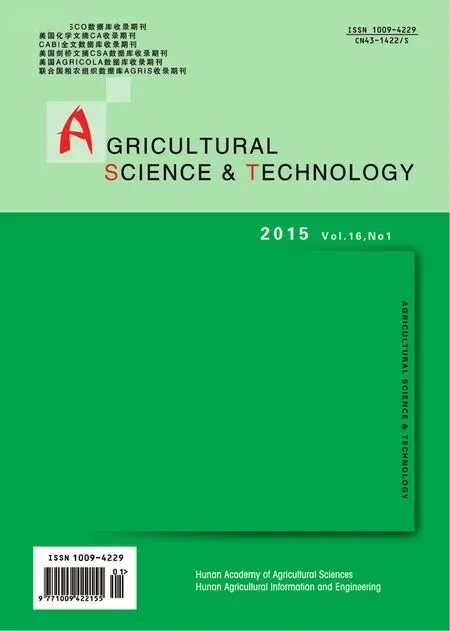Influences of Various Environmental Factors on the Degradation of Deoxynivalenol in Wheat Grains
Mingna SUN, Mei WANG, Xu DONG, Qingqing XIAO, Jinsheng DUAN, Tongchun GAO
Institute of Plant Protection and Agro-Products Safety, Anhui Academy of Agricultural Sciences / Key Laboratory of Agro-Product Safety Risk Evaluation (Hefei), Ministry of Agriculture / Anhui Kewei Pesticide and Heavy Residue Testing Center, Hefei 230031,China
Wheat head blight is the world’s most important disease in wheat production[1].As the major pathogen causing wheat head blight[2-3],Fusarium graminearum produces deoxynivalenol (DON) that plays an important role in the pathopoiesis of F. graminearum and exhibits certain biological activities to all eukaryotes, which can inhibit protein synthesis in all eukaryotes and induce cell apoptosis,thereby endangering mammals[4]. In addition, DON can exist for a long time in the food chain with strong carcinogenicity, thus posing a serious threat to human and animal health[5-6].To guarantee human and animal health, Food and Agriculture Organization of the United Nations (FAO) stipulates that the content of DON toxin in food and feed should be within 1 and 5 mg/kg,respectively[7];China government has developed national standards to define that the content of DON in wheat, wheat flour and corn should be within 1 mg/kg[8-9].However, at present, no studies have been reported on changes of the degradation of DON toxin in wheat. In this study, the degradation of DON under various environmental factors was analyzed, aiming at providing a scientific basis for exploring the variation law of the levels of DON produced by F.graminearum.
Materials and Methods
Instruments and reagents
GPT-300 light incubator (Changzhou Zhongjie Instrument Co., Ltd.);RXZ-318 Intelligent Artificial Climate Chamber (Ningbo Dongnan Instrument Co., Ltd.); BSP-250 Biochemical Incubator(Shanghai Boxun Industry &Commerce Co., Ltd.); triple-quadrupole mass spectrometer LCMS-8030(Shimadzu Corporation); methanol,acetonitrile, ammonia were of chro-matographic grade; other reagents were of analytical grade; deoxynivalenol (DON) standards were purchased from Fermentek,Ltd.
Methods
Sample processing Healthy wheat grains(Yangmai 56)were soaked with water for 12 h and sterilized by autoclaving before use. Highly-virulent F. graminearum strain was used as the experimental strain, which was pre-incubated on the culture medium,inoculated to sterilized wheat grains,incubated at 25 ℃with shaking every 24 h to prevent agglomeration, and dried after 28 d before use. To ensure sample homogeneity, all inoculated wheat samples were ground evenly into powder using a grinder, and dried at 60 ℃for 5 h until water was completely evaporated. Subsequently,dried samples were treated under different environmental conditions. Respectively 3.0 g(dry weight)of experimental samples were collected at 0,5,10,15,20,30,40,50,60,70,90,110,130 and 150 d post-treatment with three replications for toxin detection.The detection results were fitted according to first-order kinetic equation to calculate the degradation half-life.
Influences of various environmental factors on the degradation of DON toxin
Influences of different temperature conditions on the degradation of DON toxin Under natural light and humidity conditions, inoculated wheat grains were incubated indoors at 25 and 50 ℃,respectively.
Influences of different humidity conditions on the degradation of DON toxin Under natural light,25 ℃conditions, inoculated wheat grains were incubated indoors at 50% and 90%humidity,respectively.
Influences of different light conditions on the degradation of DON toxin Under natural humidity, 25 ℃conditions, inoculated wheat grains were incubated indoors in the dark and under strong light illumination (10 000 lx),respectively.
Sample detection Accurately 3.0 g of wheat powder in different treatments was weighed, added into 20 ml of extraction buffer (acetonitrile∶water=84 ∶16, V∶V), homogenated for 1 min,filtered into a separatory funnel,added with an appropriate amount of solid NaCl, shaken for 1 min, placed at room temperature for layering. The upper acetonitrile layer was collected,concentrated, dissolved in 2 ml of acetonitrile, added with 0.1 g of PSA and 0.1 g of anhydrous magnesium adsorbent,mixed with a vortex,placed at room temperature, and sifted through a 0.22 μm filter membrane before sample loading.
LC-MS/MS conditions Shimadzu mass spectrometer: LCMS-8030;chromatographic column: Shimadzu Shim-pack XR-ODSIII, 50 mm × 2.0 mm; mobile phase: A phase, 0.01%ammonia, B phase, methanol; flow rate:0.4 ml/min;injection volume:5 μl;column temperature: 40 ℃; elution mode: gradient elution; B phase initial concentration: 10%. Gradient elution program was shown in Table 1.
MS conditions:ESI-,-3.5 kV;atomization gas,nitrogen 3.0 L/min;drying gas, nitrogen 20 L/min; collision gas, argon 230 kPa; desolvation temperature,250 ℃;heating temperature,450 ℃. Multiple reaction monitoring(MRM) parameters of deoxynivalenol(DON)were shown in Table 2.

Table 1 Gradient elution program

Table 2 Multiple reaction monitoring(MRM)parameters of deoxynivalenol(DON)
Results and Analysis
Standard curve and linear relationship
Within the concentration range of 10-1 000 μg/L, the linear regression equation between DON standard sample concentration (μg/L) and mass peak area (Area) was Y=45.429 5X-1 705.65, and the correlation coefficient was r=0.994 0. The drawn standard curve was shown in Fig.1. Chromatogram and electrospray ionization(ESI) mass spectrum of standard sample were shown in Fig.2 and Fig.3.The minimum detectable concentration was 10 μg/kg.
Degradation of DON toxin under different environmental conditions Influences of temperature on the degradation of DON toxin Under the indoor natural light and humidity conditions,after being treated at 25 ℃for 150 d,the degradation rate of DON toxin in wheat grains reached 87.00%,and the degradation half-life was 58.24 d; after being treated at 50 ℃for 150 d,the degradation rate of DON toxin in wheat grains reached 80.77%,and the degradation half-life was 69.30 d.Moreover, DON toxin treated at room temperature exhibited higher degradation rate and shorter degradation halflife than that treated at high temperature, indicating that rising temperature could not accelerate significantly the degradation of DON toxin but reduced the degradation rate(Table 3,Fig.4).
Influences of humidity on the degradation of DON toxin Under the indoor natural light and 25 ℃conditions, after being treated at 50% humidity for 150 d, the degradation rate of DON toxin in wheat grains reached 84.23%, and the degradation half-life was 71.44 d; after being treated at 90% humidity for 150 d, the degradation rate of DON toxin in wheat grains reached 86.59%, and the degradation half-life was 54.57 d.DON toxin treated at a normal humidity (50%) exhibited relatively lower degradation rate and longer degradation half-life than that treated at a high humidity (90%),indicating that high humidity environment could slightly accelerate thedegradation of DON toxin (Table 3 ,Fig.5).
Influences of light on the degradation of DON toxin Under the indoor natural humidity and 25 ℃conditions,after being treated in the dark for 150 d,the degradation rate of DON toxin in wheat grains reached 78.85%,and the degradation half-life was 70.71 d;after being treated under strong light illumination at 10 000 lx for 150 d, the degradation rate of DON toxin in wheat grains reached 83.64%,and the degradation half-life was 67.94 d.DON toxin treated under strong light illumination exhibited higher degradation rate and shorter degradation half-life than that treated in the dark,indicating that strong light illumination could accelerate significantly the degradation of DON toxin(Table 3,Fig.6).
Further studies showed that, under the same natural humidity and 25℃conditions, among three different light treatments(dark,strong light,natural light), DON toxin treated under natural light illumination for 150 d exhibited the highest degradation rate(87.00%)and the shortest degradation half-life(58.24 d).Furthermore,natural light treatment was conducted under alternate dark and light conditions,which was significantly different from the continuous darkness or strong light.
Discussions
According to previous studies, deoxynivalenol is difficult to be degraded in wheat[11]. The concentration of DON toxin in wheat stored under moisture content of 17% -20% varies significantly[10]. In addition, Fusarium graminearum in infected wheat grains harvest in the field is generally composed of multiple strains. To avoid the interference of the above factors in subsequent trials, healthy wheat grains should be sterilized at high temperature at first, inoculated with purified F. graminearum strains for toxin-producing cultivation, and dried to obtain finally uniform infected grains.
In this study, after being treated under different conditions for 150 d,DON toxin in wheat grains exhibited the degradation rate of 78.85% -87.00% and degradation half-life of 54.57-71.44 d. Therefore, DON toxin belongs to a class of refractory compounds. Different humidity treatments affected the degradation of DON toxin mainly by changing moisture content in wheat grains, which is consistent with related reports[12].
In China,warm and rainy weather occurs frequently at flowering stage of wheat in wheat-producing areas such as the Yangtze River Basin,which provides favorable environmental conditions for the infection of F. graminearum[13].During June-July after wheat harvest, the middle and lower reaches of Yangtze River encounter frequent rainy season,which easily leads to deoxynivalenol toxin residues in wheat at post-harvest storage stage in wheatproducing areas along the Yangtze River Basin, such as Anhui, Jiangsu and other provinces. In the present study, the influences of temperature,humidity and light on the degradation of DON in wheat grains were investigated. According to the accelerating effects of different conditions on DON degradation,natural light >strong light(10 000 lx)>darkness,90%humidity >50% humidity, but high temperature could not accelerate the degradation of DON toxin. However, in actual production and storage process, wheat easily gets mildewed at 90% humidity,which suggests that the degradation rate of DON may be changed by increasing the humidity, but the actual operation is relatively difficult. Therefore,the residual quantity of DON toxin in stored wheat can be reduced by increasing the light intensity or changing the continuous darkness at storage stage.

Table 3 Degradation of DON toxin under different environmental conditions
[1]CHEN LF, BAI GH, DESJARDINS AE.Recent advances in wheat head scab research in China. National Agricultural Library (http://www.nal.usda.gov/pgdic/WHS/whsindex.html),2000.
[2]QU B, LI HP, ZHANG JB, et al. Geographic distribution and genetic diversity of Fusarium graminearum and F. asiaticum on wheat spikes throughout China[J].Plant Pathology,2008,57(1):15-24.
[3]ZHANG JB,LI HP,DANG FJ,et al.Determination of the trichothecene mycotoxin chemotypes and associated geographical distribution and phylogenetic species of the Fusarium graminearum clade from China [J]. Mycological Research,2007,111(8):967-975.
[4]YANG GH, JARVIS BB, CHUNG YJ, et al. Apoptosis induction by the satratoxins and other trichothence myeotoxins:relationship to ERK, p38 MARK, and SAPK/JNK activation [J]. Toxicol App Pharmacol,2000,164:149-160.
[5]FORSYTH OM, YOSHIZAWA T, MOROOKA N. Emetic and refusal activity of deoxynivalenol to swine [J]. Applied and Environmental Microbiology,1977,34:547-552.
[6]SNIJDERS CHA. Fusarium head blight and mycotoxin contamination of wheat,a review [J]. Netherlands Journal of Plant Pathology,1990,96:187-198.
[7]WHO. Gems/Food regional diets, food safety issues, food safety department revision.2003.
[8]GBl6329-1996, Tolerance limits for deoxynivalenol in wheat , wheat flour ,corn and corn flour(小麦、面粉、玉米及玉米粉中脱氧雪腐镰刀菌烯醇限量标准) [S]. Beijing: China Standard Press(北京:中国标准出版社),1996.
[9]GB 2761-2011, Maximum levels of mycotoxins in foods(食品中真菌毒素限量)[S]. Beijing: China Standard Press (北京:中国标准出版社),2011.
[10]ABRAMOSON D. Mycotoxins, ergosterol and odor volatiles in durum wheat during granary storage at 16% and 20% moisture content [J]. Journal of Stored Products Research, 2005, 41:67-76.
[11]FAN SP (樊声平).Study on the regu-larity of carbendazim resistant population evolution and DON toxin producing Fusarium graminearum (禾谷镰刀菌多菌灵抗药性群体演变及DON 毒素产生规律研究) [D]. Nanjing: Nanjing Agricultural University(南京:南京农业大学),2008:107-111.
[12]LARSEN JC,HUNT J,PERRIN I,et al.Workshop on trichothecenes with a focus on DON:summary report[J].Toxicoloy Letters,2004,153:1-22.
[13]LU WZ(陆维忠),CHENG SH(程顺和),WANG YZ (王裕中). Study on Wheat Head Blight (小麦赤霉病研究)[M].Beijing:Science Press(北京:科学出版社),2001.1-44.
 Agricultural Science & Technology2015年1期
Agricultural Science & Technology2015年1期
- Agricultural Science & Technology的其它文章
- Optimization Model of the Effects of Transplanting Density,Nitrogen and Potassium Fertilization on Yield and Quality of an Aromatic Hybrid Rice "Luyoumingzhan"
- Effects of Anti-wind Erosion with Peanut Stubbles in Sandy Lands during Fallow Period
- Analysis on Resistance of Rice Cultivar Lianjing 7 to Rice Black-streaked Dwarf Disease
- Reduction of Cd,Cu,Ni and Pb Mobility by Active Si
- Seed Morphology and Seedling Variation of Four Ornamental Lupin Pedigrees
- Effects of Planting Density on Yield and Mechanical Harvesting Loss Rate of Brassica napus L.
